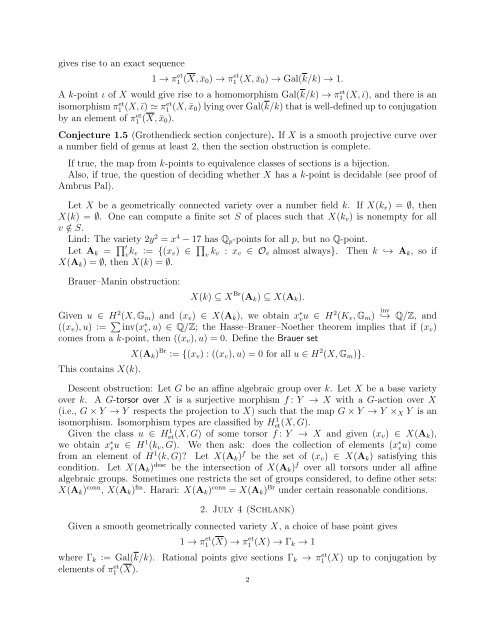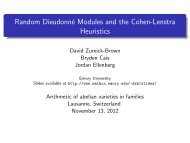alternative lecture notes - Rational points and algebraic cycles
alternative lecture notes - Rational points and algebraic cycles
alternative lecture notes - Rational points and algebraic cycles
You also want an ePaper? Increase the reach of your titles
YUMPU automatically turns print PDFs into web optimized ePapers that Google loves.
gives rise to an exact sequence<br />
1 → π et<br />
1 (X, ¯x 0 ) → π et<br />
1 (X, ¯x 0 ) → Gal(k/k) → 1.<br />
A k-point ι of X would give rise to a homomorphism Gal(k/k) → π1 et (X, ῑ), <strong>and</strong> there is an<br />
isomorphism π1 et (X, ῑ) ≃ π1 et (X, ¯x 0 ) lying over Gal(k/k) that is well-defined up to conjugation<br />
by an element of π1 et (X, ¯x 0 ).<br />
Conjecture 1.5 (Grothendieck section conjecture). If X is a smooth projective curve over<br />
a number field of genus at least 2, then the section obstruction is complete.<br />
If true, the map from k-<strong>points</strong> to equivalence classes of sections is a bijection.<br />
Also, if true, the question of deciding whether X has a k-point is decidable (see proof of<br />
Ambrus Pal).<br />
Let X be a geometrically connected variety over a number field k. If X(k v ) = ∅, then<br />
X(k) = ∅. One can compute a finite set S of places such that X(k v ) is nonempty for all<br />
v /∈ S.<br />
Lind: The variety 2y 2 = x 4 − 17 has Q p -<strong>points</strong> for all p, but no Q-point.<br />
Let A k = ∏ ′<br />
v k v := {(x v ) ∈ ∏ v k v : x v ∈ O v almost always}. Then k ↩→ A k , so if<br />
X(A k ) = ∅, then X(k) = ∅.<br />
Brauer–Manin obstruction:<br />
X(k) ⊆ X Br (A k ) ⊆ X(A k ).<br />
Given u ∈ H 2 (X, G m ) <strong>and</strong> (x v ) ∈ X(A k ), we obtain x ∗ vu ∈ H 2 (K v , G m ) inv<br />
↩→ Q/Z, <strong>and</strong><br />
((x v ), u) := ∑ inv(x ∗ v, u) ∈ Q/Z; the Hasse–Brauer–Noether theorem implies that if (x v )<br />
comes from a k-point, then ((x v ), u) = 0. Define the Brauer set<br />
This contains X(k).<br />
X(A k ) Br := {(x v ) : ((x v ), u) = 0 for all u ∈ H 2 (X, G m )}.<br />
Descent obstruction: Let G be an affine <strong>algebraic</strong> group over k. Let X be a base variety<br />
over k. A G-torsor over X is a surjective morphism f : Y → X with a G-action over X<br />
(i.e., G × Y → Y respects the projection to X) such that the map G × Y → Y × X Y is an<br />
isomorphism. Isomorphism types are classified by Het(X, 1 G).<br />
Given the class u ∈ Het(X, 1 G) of some torsor f : Y → X <strong>and</strong> given (x v ) ∈ X(A k ),<br />
we obtain x ∗ vu ∈ H 1 (k v , G). We then ask: does the collection of elements (x ∗ vu) come<br />
from an element of H 1 (k, G)? Let X(A k ) f be the set of (x v ) ∈ X(A k ) satisfying this<br />
condition. Let X(A k ) desc be the intersection of X(A k ) f over all torsors under all affine<br />
<strong>algebraic</strong> groups. Sometimes one restricts the set of groups considered, to define other sets:<br />
X(A k ) conn , X(A k ) fin . Harari: X(A k ) conn = X(A k ) Br under certain reasonable conditions.<br />
2. July 4 (Schlank)<br />
Given a smooth geometrically connected variety X, a choice of base point gives<br />
1 → π et<br />
1 (X) → π et<br />
1 (X) → Γ k → 1<br />
where Γ k := Gal(k/k). <strong>Rational</strong> <strong>points</strong> give sections Γ k → π1 et (X) up to conjugation by<br />
elements of π1 et (X).<br />
2



